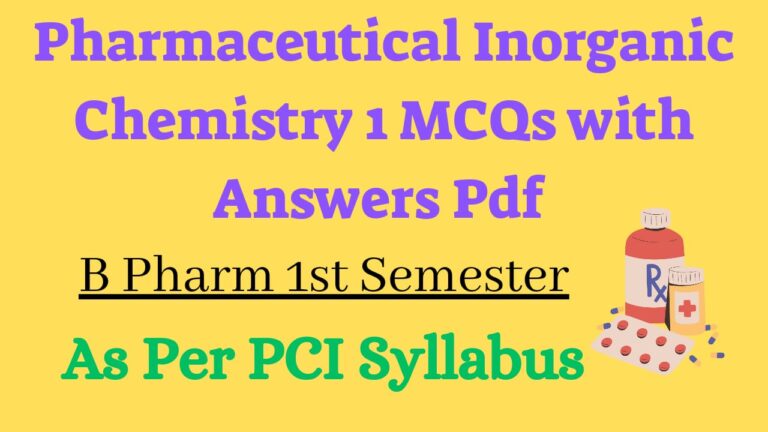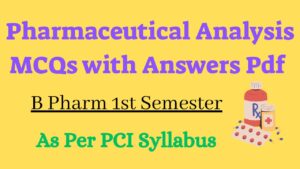Download pharmaceutical inorganic chemistry MCQs with answers pdf for b pharmacy 1st semester. These pharmaceutical inorganic chemistry MCQs with answers pdf are very useful for the b pharmacy students for their board final examination.
All the b pharm pharmaceutical inorganic chemistry 1 multiple choice questions are prepared by renowned professors from different universities in India. These pharmaceutical inorganic chemistry MCQs with answers are very much important for the exam purpose.
In this article , we will provide most important pharmaceutical inorganic chemistry MCQs with answers. We provide 10 MCQs from each of the units of b pharm 1st semester pharmaceutical inorganic chemistry.

Pharmaceutical Inorganic Chemistry MCQs with Answers
We have provided below all the pharmaceutical inorganic chemistry 1 mcqs with answers systematically.
We also provide all b pharmacy study materials like b pharmacy notes , b pharmacy books , b pharmacy previous year question paper etc for free.
Pharmaceutical Impurities and General Methods of Preparation
1. The standard solution of arsenic contains
(A) Arsenious acid
(B) Arsenic acid
(C) Arsine
(D) Arsenic oxide
Ans. D) Arsenic oxide
2. One of the following limit tests is based on the Comparison of colour
(A) Limit test of sulphate
(B) Limit test of chloride
(C) Limit test of iron
(D) A & C
Ans. D) A & C
3. Thioglycolic acid is used in a limit test of iron because
(A) It provides an acidic medium
(B) It reduces ferric iron to ferrous iron
(C) It gives purple coloured complex with iron
(D) B & C
Ans. D) B & C
4. Inorganic compounds generally do not Contain……… atoms
(A) Nitrogen
(B) Carbon
(C) Oxygen
(D) Sulphur
Ans. B) Carbon
5. Washing soda is
(A) Sodium carbonate
(B) Sodium bicarbonate
(C) Sodium sulphite
(D) Sodalimne
Ans. A) Sodium carbonate
6. What is added in preparation of barium Sulphate reagent to prevent super Saturation
(A) Ethanol
(B) BaCl2
(C) K2S04
(D) A & B
Ans. A) Ethanol
7. The function of granulated Zn in the limit test For Arsenic is
(A) Low and prolonged evolution of Nascent H2 gas
(B) High and prolonged evolution of Nascent H2 gas
(C) Low and prolonged evolution of Nascent N2 gas
(D) Low and prolonged evolution of Nascent N2 gas
Ans. A) Low and prolonged evolution of Nascent H2 gas
8. The reagent used in a limit test of chloride
(A) Silver nitrate
(B) Nitric acid
(C) Nitric oxide
(D) All of these
Ans. A) Silver nitrate
9. Limit test for Pb has been based b/w……. And….. upon reaction to form Complex
(A) Pb and dithione
(B) Guizet test
(C) Arsine
(D) Mercuric chloride
Ans. A) Pb and dithione
10. Limit test for Heavy Metals is carried out To identify and control impurities
(A) Mercury
(B) Cadmium
(C) Bismuth
(D) All of the above
Ans. D) All of the above
ALSO DOWNLOAD :-
Buffers, Electrolytes and Dental Products MCQ
1. Extracellular fluid includes
(A) Vascular fluid only
(B) Intestinal and vascular fluid
(C) Intestinal fluid only
(D) None of these
Ans. B) Intestinal and vascular fluid
2. The basic objective of replacement therapy is
(A) To restore the volume and composition of body fluids
(B) To restore the volume only
(C) To restore the composition of body fluids only
(D) None of these
Ans. A) To restore the volume and composition of body fluids
3. Buffer solutions are those which resist the Change in
(A) PH
(B) Colour
(C) Acidity
(D) Alkalinity
Ans. A) PH
4. ORS has a composition of a) NaCl, b) KCI, c) Sodium citrate, d) Sodium bicarbonate, e) Glucose
(A) A, b, c, d
(B) A, b, c, e
(C) A, b, d, e
(D) B, C, d, e
Ans. B) A, b, c, e
5. Sodium Metaphosphate is also known as
(A) Precipitated chalk
(B) Both a and b
(C) Madrell’s salt
(D) None of these
Ans. C) Madrell’s salt
6. The principal function of chloride is
(A) Maintenance of proper hydration
(B) Maintenance of Osmotic pressure
(C) Normal Electrolytic balance
(D) All of the above
Ans. D) All of the above
7. Potassium therapy is contraindicated in patient
(A) Impaired renal function
(B) Acute dehydration
(C) Myotonia congenital
(D) All of the above
Ans. D) All of the above
8. Which of the following is desensitizing agents
(A) Zinc chloride
(B) Strontium chloride
(C) Both a & b
(D) Sodium fluoride
Ans. C) Both a & b
9. What is the full form of pH
(A) Positive hydrogen
(B) Potential Hydrogen
(C) Positron
(D) Proton of hydrogen
Ans. B) Potential Hydrogen
10. Which of the following is not a property of the base
(A) Taste bitter
(B) React with salts to form acid
(C) Turn red litmus blue
(D) Feel slippery on the skin
Ans. B) React with salts to form acid
Gastrointestinal Agents MCQs with Answers
1. Example of antacid
(A) Sodium Bicarbonate
(B) Calcium Hydroxide
(C) Magnesium Sulphate
(D) All of these
Ans. D) All of these
2. Burnett syndrome is associated with the prolonged use of
(A) Calcium-containing antacids
(B) Magnesium-containing antacid
(C) Aluminium containing antacid
(D) All of the above
Ans. A) All of the above
3. A combination of antacids is prepared because
(A) To attain the synergistic effect
(B) To enhance the antacid effect
(C) An attempt to balance the consti- passive effect of calcium and aluminium with the laxative effect of magnesium
(D) All of these
Ans. C) An attempt to balance the consti- passive effect of calcium and aluminium with the laxative effect of magnesium
4. Bismuth Sub carbonate is used as
(A) Antidiarrheal
(B) Mild antacid
(C) Mild antiseptic and astringent
(D) All of these
Ans. D) All of these
5. The drug which promotes defecation is Called
(A) Purgative
(B) Laxative
(C) Cathartic
(D) Protective
Ans. A) Purgative
6. Expectorants are used in the treatment of the Respiratory tract by
(A) Increase viscosity of bronchial sec
(B) decrease Viscosity of bronchial sec
(C) Increase Amount of refractory tract fluid a demulcent action is an extract
(D) Both (b) and (c)
Ans. A) Increase viscosity of bronchial sec
7. The condition in which excessive secretion Of gastric HCL is called as
(A) Achlorhydria
(B) Hyperchlorhydria
(C) Hypoacidity
(D) None of the above
Ans. B) Hyperchlorhydria
8. Aluminium hydroxide gel is used as
(A) Cathartic
(B) Protective and absorbent
(C) Acidifying agent
(D) Antacids
Ans. D) Antacids
9. A combination of antacids is Used because
(A) Reduces constipation effect
(B) Reduce laxative action
(C) Produces synergistic action
(D) All the above
Ans. D) All the above
10. Which is not a class of topical agents
(A) Antibiotic
(B) Protectives
(C) Antimicrobial
(D) Astringents
Ans. A) Antibiotic
Expectorants, Emetics, Haematinics & Poison MCQs
1. Alum is commonly used as
(A) Anti-infective
(B) Astringent
(C) Protectives
(D) All of these
Ans. B) Astringent
2. The progastrokinetic action of the Following drug(S) is attenuated by atropine
(A) Domperidone
(B) Metoclopramide
(C) Cisapride
(D) Both ‘b’ and ‘c’
Ans.D) Both ‘b’ and ‘c’
3. Ondansetron blocks emetogenic impulses At the following site(s)
(A) Vagal afferents in intestines
(B) Nucleus tractus solitarius
(C) Chemoreceptor trigger zone
(D) All of the above
Ans. D) All of the above
4. All of the following symptoms can occur With Ciguatera poisoning
(A) Myalgias
(B) Flushing
(C) Metallic taste
(D) Reversal of temperature sensation
Ans. B) Flushing
5. Indicate the drug which does not improve Lower oesophagal sphincter tone or Prevent gastroesophageal reflux, but is used as first-line treatment of Gastro oesophagal reflux disease
(A) Sodium alginate + Aluminium hydroxide gel
(B) Omeprazole
(C) Mosapride
(D) Famotidine
Ans. A) Sodium alginate + Aluminium hydroxide gel
6. Ferrous sulfate is also known as
(A) Blue vitriol
(B) Caustic potash
(C) Condy’s Crystals
(D) Melanterite
Ans. D) Melanterite
7. How do astringents act
(A) Lipid precipitant
(B) Protein precipitant
(C) Bacterial inhibition
(D) Both b and c
Ans. D) Both b and c
8. After inhalation oxygen combines with haemoglobin the formed complex is
(A) Carboxyhaemoglobin
(B) Oxyhaemoglobin
(C) Dioxyhemoglobin
(D) Carboxyhaemoglobin
Ans. B) Oxyhaemoglobin
9. The requirements for Folic acid in pregnant Women is
(A) 0.8 mg/day
(B) 1 mg/day
(C) 0.1 mg/day
(D) 0.3 mg/day
Ans. A) 0.8 mg/day
10. Zinc sulphate is prepared by the action of ………On Zinc Oxide
(A) Conc. HCI
(B) Conc. H2S04
(C) Conc. HN03
(D) None of these
Ans. B) Conc. H2S04
Radiopharmaceuticals MCQ with Answers
1. The age of a tree is determined using radio-Isotope of
(A) Phosphorus
(B) Iodine
(C) Cobalt
(D) Carbon
Ans. D) Carbon
2. Which of the following acts as quenching Gas in Geiger Muller counter
(A) Alcohol
(B) Argon gas
(C) Krypton
(D) Hydrogen
Ans. A) Alcohol
3. What problem might you foresee in Labelling a drug as shown
(A) The isotope could be easily lost since it is exchangeable with water
(B) The isotope could be lost as a result of a metabolic oxidation
(C) The isotope could be lost since it is acidic
(D) The isotope could be lost as a result of hydrolysis
Ans. D) The isotope could be lost as a result of hydrolysis
4. The S.I. unit of radioactivity is
(A) Roentgen
(B) Becquerel
(C) Curie
(D) Rutherford
Ans. B) Becquerel
5. The half-life period of radium is 1600 Years. Its average lifetime will be
(A) 4800 years
(B) 2319 years
(C) 3200 years
(D) 4217 years
Ans. B) 2319 years
6. The effect of radioactive particles passing Through biological tissue depends upon
(A) The ability of the radiation to penetrate tissue
(B) The energy of radiation
(C) The dose rate of the radiation
(D) All of the above
Ans. D) All of the above
7. Radioactivity is due to
(A) Stable electronic configuration
(B) Stable nucleus
(C) Unstable electronic configuration
(D) Unstable nucleus
Ans. D) Unstable nucleus
8. When the difference between the mass Number and atomic number of atoms of Two or more elements are the same, the atoms Are known as
(A) Isotopes
(B) Isotones
(C) Isobars
(D) Nuclear isomers
Ans. B) Isotones
9. 1 Becquerel is equivalent to
(A) 2.7 x 10-11 curie
(B) 2.7 x 10-10 curie
(C) 2.7 x 10-8 curie
(D) 2.7 x 10-5 curie
Ans. A) 2.7 x 10-11 curie
10. A device used for the measurement of Radioactivity is a
(A) Mass spectrophotometer
(B) Nuclear reactor
(C) Cyclotron
(D) G.M. Counter
Ans. D) G.M. Counter
Disclaimer
The content of Pharmaedu.in is provided for information and educational purposes only. WE are not the owner of any PDF Material/Books/Notes/Articles published on this website. No claim is made as to the accuracy or authenticity of the PDF Material/Books/Notes/Articles of the website.In no event will this site or owner be liable for the accuracy of the information contained on this website or its use.
Pharmaedu provides freely available PDF Materials/Books/Notes/Articles on the internet or other resources like Links etc. This site doesn’t take any responsibility and legal obligations due to the illegal use and abuse of any information published on the website.No responsibility is taken for any information that may appear on any linked websites.
Conclusion
If you find this ”Pharmaceutical inorganic chemistry MCQs with answers pdf download 2023 ” helpful then don’t forget to share with your friends.If you need any other study materials then go through our website.




